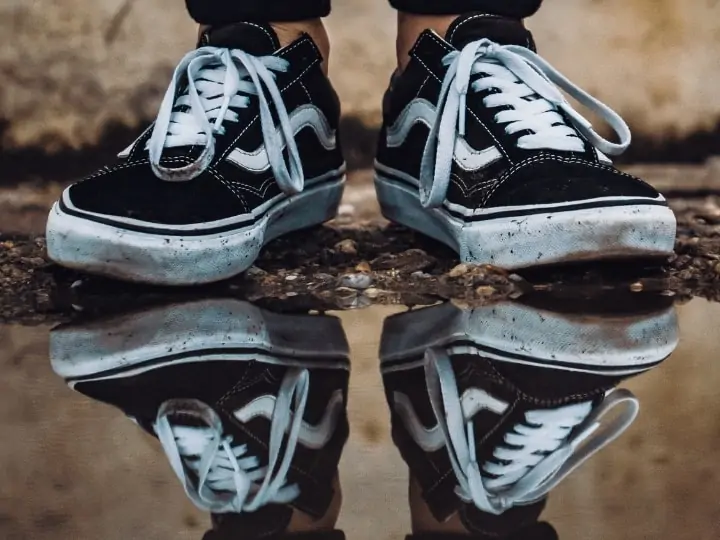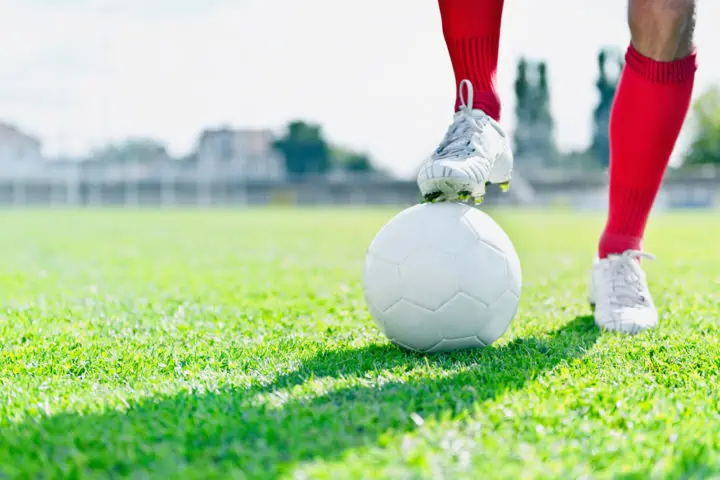Share the post "Are Vans Good For Soccer? (Footwear You Need)"
Soccer is a dynamic sport that involves different types of movements, from sharp turns to powerful field-length sprints. Soccer requires specialist footwear, called cleats.
Cleats are specifically designed to provide superior grip on grass soccer fields. Cleat exteriors tend to be made from leather or a combination of synthetic materials, giving the wearer an excellent feel, enabling them to control the ball and strike it cleanly.
Although we’re accustomed to professional players wearing cleats, have you ever wondered if other types of footwear are suitable for the movement and kicking requirements of soccer?
As some of the most popular sneaker brands on the planet, how would Vans fare?
This article tackles the topic of footwear in soccer and answers the question of whether or not Vans are good for playing the beautiful game.

Are Vans Good For Soccer?
While you may get away with kicking a ball around in your backyard in a pair of Vans, they are not good shoes for soccer.
The material, weight, shape, and style, make shooting and dribbling a challenge, and allow too much movement within the shoe.
Main Disadvantages of Vans For Soccer
The main disadvantages of Vans for soccer include:
- Lack of studs for gripping grass and turf.
- Flat sole and round shape doesn’t form to the shape of the foot.
- Canvas material absorbs water, making the shoes heavy.
- Vans’ signature thick rubber soles make it difficult to strike the ball cleanly.
- Lack of flexibility hinders movement for soccer.
- Vans insoles don’t offer the same amount of arch support as soccer cleats.

Benefits of Vans For Soccer
Despite the disadvantages, Vans are a reliable shoe and have some benefits when it comes to soccer. However, it’s important to note that the following advantages are for casual, backyard soccer, rather than competitive games.
- Double stitching gives them durability, meaning they’re unlikely to fall apart too quickly.
- Designed for skating, Vans offer superior grip to other types of regular sneakers.
- Vans have cushioned insoles and padded heels, protecting your foot while playing.
- Much more affordable than proper soccer cleats.

What Do the Rules Say?
According to the International Football Association Board (IFAB), the independent body that develops and determines the “Laws of the Game of association football”, players aren’t required to wear any specific type of footwear.
IFAB Law 4, “The Players’ Equipment”, states that footwear is compulsory but it doesn’t mention any special criteria.
This may come as a surprise as all professional players wear cleats in every single game. Even at an amateur level virtually all players wear specialist soccer cleats.
Local amateur soccer leagues often have stricter equipment regulations, requiring all players to wear studded, molded, or bladed cleats for grass games.
This is generally enforced in the interest of safety for all of the players.
What Shoes Are Good For Soccer?
As we’ve discussed, specially designed footwear is recommended for soccer. However, depending on the type of playing surface, different types of cleats may be more suitable.
Types of Cleats
In the amateurs, soccer may be played on a range of surfaces, including astroturf, natural grass, or dirt fields. In the professional leagues, games are played predominantly on astroturf or natural turf.
Artificial soccer fields are very common in the United States but most European teams play on natural or hybrid surfaces.
In certain leagues, such as the English Premier League, artificial soccer fields are prohibited.
With such a disparity in playing surfaces, different types of cleats are worn for different surfaces.
Studded Cleats
Most soccer cleats contain multiple metal or plastic studs. These are arranged and designed to dig into the turf to give the wearer grip and stability.
Studs help players to run, turn, jump, and balance as they kick and dribble the ball. Without them, players would constantly slip and slide around the field, especially when it’s wet.
The technology surrounding soccer cleats has progressed significantly over the years. This has led to the development of specialist studs for different types of turf and the firmness of the ground.
Hard Ground
Hard ground studs are usually made from plastic and are typically quite short. This gives them an adequate grip of the turf, without causing pain or distress to the sole of your foot.
Soft Ground
Unfortunately, not all soccer fields are kept in good condition. In rainy areas, muddy pitches are often unavoidable.
Hard ground studs may not provide you with enough grip to perform optimally on soft turf. Soft ground studs or blades are usually made from metal, ensuring they can penetrate the ground, giving you grip and mobility in difficult conditions.

Artificial Ground
Artificial soccer fields can differ significantly. At an amateur level, an artificial soccer field is likely to be made from 100% synthetic fibers.
Professional artificial soccer fields are usually third-generation synthetic surfaces (3G), which are made from a combination of synthetic turf fibers, sand, and rubber infill.
For shallow artificial soccer fields, studs aren’t necessary. Footwear for basic astroturf contains multiple closely configured, rubber, dimple-style studs. These allow the wearer to gain sufficient traction, without hard studs pushing back into the sole of the foot.
Thicker astroturf, like 3G fields, give players more freedom as to what footwear they choose. Metal or plastic studs and blades may be suitable for longer artificial grass.
Premier League, La Liga, and MLS players can typically choose between plastic or rubber molded studs due to the high quality of the fields they play on.
Indoor
Indoor soccer and futsal players usually wear rubber-soled shoes with dimple-style studs to give them maximum grip on wooden or plastic surfaces.
The shoe exterior is typically made from durable material and contains padding and ankle support to enable quick turning and dynamic movements.
What To Look Out For In Soccer Cleats
There are several important things to look out for in a soccer cleat, such as:
Weight
The weight of a good soccer cleat is a matter of personal preference. While some players enjoy the maneuverability of a super lightweight shoe, others prefer the support from a heavy, chunkier cleat.
The type of surface you play on may also influence the weight of the cleat you wear.
Players who take to muddy fields every week may be more inclined to wear heavier, leather cleats for improved grip and support.
Players whose seasons fall during warm weather are often more inclined to wear lightweight pairs for improved mobility.
Texture and Materials
The texture and material of your cleats should not be overlooked.
The best performing cleats are made using leather or synthetic materials, creating comfortable, durable cleats that give you maximum control.
Fit
Don’t sacrifice style for fit when it comes to soccer cleats.
The fit of the shoe is crucial for virtually every aspect of the game, from shooting to controlling passes. Loose cleats may impede your ability to run and shoot.
While you might enjoy a tight-fitted cleat, ensure they aren’t too tight. Overly tight cleats can cause long-term injuries, blisters, scratches, and nail issues.

Things To Avoid
When shopping for cleats, it’s important to look out for red flags. Things to avoid include:
- Purchasing footwear based on looks only.
- Purchasing cleats based on someone else’s opinion (e.g. online reviews).
- Sacrificing quality for price.
- Rushing into a purchase.
- Choosing the wrong studs or blades.
Do Different Cleats Suit Certain Positions?
Traditionally, the “no-nonsense” type players, such as goalkeepers, defenders, and combative midfielders wore heavy leather boots with ample support and padding.
Flair players and strikers wore lighter footwear, improving their agility and dribbling ability.
In the modern game, players in all positions wear different types of cleats. Goalkeepers often wear the same brand and model of the shoe as the striker.
Sponsorship deals have more of an influence on cleat choice.
However, professionals often wear custom cleats that are molded to their feet. This means they can add material or extra support in different areas if necessary.
What the Pros Wear
Nike and Adidas are by far the most popular brands of soccer cleats.
Nike cleats are worn by high-profile soccer stars such as Cristiano Ronaldo, Neymar, and Kylian Mbappé.
Soccer players sponsored by Adidas include Lionel Messi, Paul Pogba, and Paulo Dybala.
Choosing the right footwear for soccer is important for your safety and skills. Think twice the next time you throw on a pair of Vans for a game.
Share the post "Are Vans Good For Soccer? (Footwear You Need)"
Joel is a seasoned soccer journalist and analyst with many years of experience in the field. Joel specializes in game analysis, player profiles, transfer news, and has a keen eye for the tactical nuances of the game. He played at various levels in the game and coached teams - he is happy to share his insight with you.



